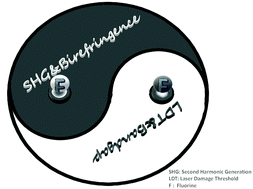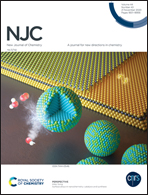The functionality of tetrahedral units in fluoroxoiodates: fluorine-modulating effects in iodates with lone pair electrons†
Abstract
Achieving a good balance between band gap and nonlinear optical (NLO) coefficient (dij) in new infrared (IR) NLO candidates is still a challenge. Introducing lone pair electrons in numerous NLO materials can enhance the second harmonic generation (SHG) effects and possibly enrich structural diversity, but it leads to a redshift of the cut-off edge. Therefore, a modulation strategy is needed to balance the SHG effects and band gap. In this work, the discrepancy of the SHG responses of typical iodates AIO3 and fluoroxoiodates AIO2F2 (A = Na, K, Rb, Cs) was analyzed. The results showed that the introduction of fluorine can modulate the effect of the stereochemical activity of lone pairs in iodates. Because of the different bonding behaviors between I–O and I–F, fluoroiodates with IO2F2 exhibit superiority in balancing the band gap and NLO response. Furthermore, by using the real-space atomic cutting method, the main contribution to NLO performance in the iodates/fluoroiodates is found to arise from the anionic groups with lone pair electrons. This work demonstrates for the first time the expanding functionality of fluorooxo-tetrahedral units in influencing the lone pair effect, which can further guide the rational design of new NLO materials with balanced performance.



 Please wait while we load your content...
Please wait while we load your content...